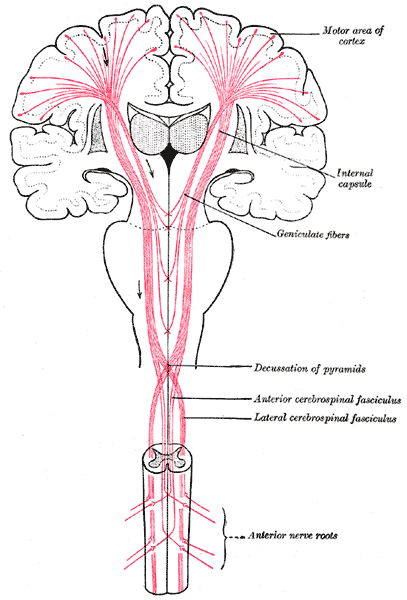Biopsychology is a field of psychology with a great deal of crossover into biology and health sciences in general and this sub-field is no exception. Many of the conditions and causes touched upon below can be further investigated in common neuroscience textbooks as well as biopsychology ones. It is also important to note that research is very much ongoing in neuroscience; much remains speculative or unknown for the time being.
The motor cortex is one of the areas of the brain responsible for triggering movement via neural messages. It can send both voluntary and involuntary movement signals through the pyramidal tracts to the spinal cord which coordinates the action. The latter stretches from moving your hand away from a hot plate to giving the knee jerk reaction at the doctor’s office to balancing both sides of your body appropriately as you walk down the street - anything not requiring cognitive input - while the former includes actions from changing the direction you are looking to painting or driving a car. Although mapping of one movement to one part of the brain is an oversimplification, there is a distinct relationship between the locality of stimulation and the action produced, as shown in work by Graziano et al. on monkeys where stimulating specific areas of the brain prompted gripping and feeding motions1.

The pathway from motor cortex to spinal cords is one of the major descending ones.
Diseases in this area of the body with psychological links include many cognitive disorders and life-span issues such as Parkinson’s and Huntington’s disease which lead to dementia. Duchennes muscular dystrophy is not a typically geriatric condition but is also linked to degeneration of the motor cortex, The lack of brain dystrophin in sufferers is thought to be the reason many also exhibit below average IQ, speech functioning and memory capabilities2. While these diseases have no cures, understanding the biological and psychological roots has allowed researchers to develop better and better treatments over the past half a century.
References:
1. Graziano, M.S.A., Moore, T. & Taylor, C.S.R., (2002). Complex Movements Evoked by Microstimulation of Precentral Cortex. CellPress. 34 (5), pp.841-851
2. Hendriksen, J., (2011). The Psychology of Duchenne Muscular Dystrophy. 2nd ed. Netherlands: Parent Project Production.
© BrainMass Inc. brainmass.com July 26, 2024, 4:28 am ad1c9bdddf